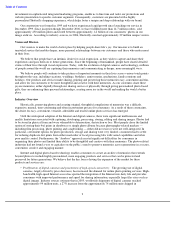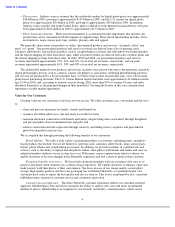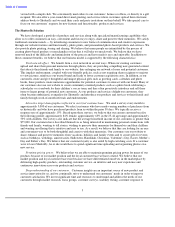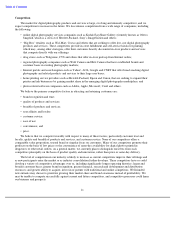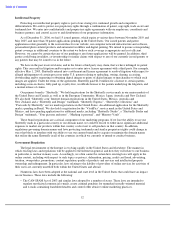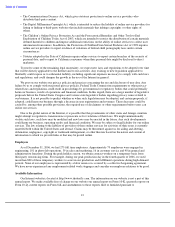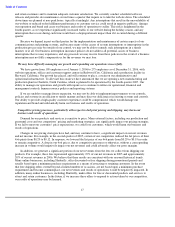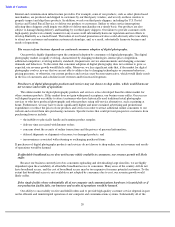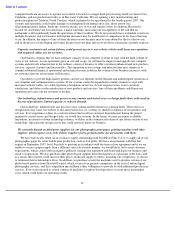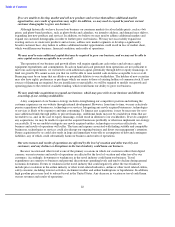Shutterfly 2007 Annual Report Download - page 17
Download and view the complete annual report
Please find page 17 of the 2007 Shutterfly annual report below. You can navigate through the pages in the report by either clicking on the pages listed below, or by using the keyword search tool below to find specific information within the annual report.
Table of Contents
Intellectual Property
Protecting our intellectual property rights is part of our strategy for continued growth and competitive
differentiation. We seek to protect our proprietary rights through a combination of patent, copyright, trade secret and
trademark law. We enter into confidentiality and proprietary rights agreements with our employees, consultants and
business partners, and control access to and distribution of our proprietary information.
As of December 31, 2006, we had 15 issued patents, which expire at various dates between November 2019 and
May 2025, and more than 30 patent applications pending in the United States. Our issued patents and patent
applications relate generally to the user interface for our website, our computer network infrastructure and software,
personalized photo-
related products and automated workflow and digital printing. We intend to pursue corresponding
patent coverage in additional countries to the extent we believe such coverage is appropriate and cost efficient.
However, we cannot be certain that any of our pending or any future applications will be granted. In addition, third
parties could bring invalidity, co-inventorship or similar claims with respect to any of our currently issued patents or
any patents that may be issued to us in the future.
We have in the past received claims, and in the future a third party may claim, that we have infringed its patent
rights. This can result in litigation and/or require us to enter into a license agreement with a third party. For example,
effective May 1, 2005, Shutterfly entered into a settlement and license agreement to resolve litigation with respect to
alleged infringement of certain processes under U.S. patents relating to uploading, storing, sharing, accessing,
downloading and/or requesting or obtaining digital images or prints of digital images or merchandise to which such
images are applied. Under the terms of the agreement, Shutterfly paid $2.0 million for a license to certain patents,
including a non-exclusive, fully-paid up, royalty-free, worldwide license to the patents underlying the litigation, and
a mutual release of claims.
Our primary brand is “Shutterfly.” We hold registrations for the Shutterfly service mark in our major markets of
the United States and Canada, as well as in the European Community, Mexico, Japan, Australia and New Zealand.
We also hold “Shutterfly.com” Internet domain registrations in the United States, Mexico, Australia and
New Zealand, and a
“Shutterfly and Design” trademark, “Shutterfly Express”, “Shutterfly Collections” and
“Postcards by Shutterfly” service mark registrations in the United States. An additional application for the Shutterfly
mark is pending in Brazil. We also hold a registration for the “VividPics” service mark in the United States and
Mexico, and have pending applications for additional marks, including “Shutterfly Studio”, a “Shutterfly Studio and
Design” trademark, “Your pictures and more”, “Marking it personal”, and “Memory Vault”.
These brand registrations are a critical component of our marketing programs. If we lose the ability to use our
Shutterfly mark in a particular country or our domain name, we could be forced to either incur significant additional
expenses to market our products within that country or elect not to sell products in that country. In addition,
regulations governing domain names and laws protecting trademarks and similar proprietary rights could change in
ways that block or interfere with our ability to use our current brand and to acquire or maintain the domain names
that utilize the name Shutterfly in all of the countries in which we currently or intend to conduct business.
Government Regulation
The legal environment of the Internet is evolving rapidly in the United States and elsewhere. The manner in
which existing laws and regulations will be applied to the Internet in general, and how they will relate to our business
in particular, is unclear in many cases. Accordingly, we often cannot be certain how existing laws will apply in the
online context, including with respect to such topics as privacy, defamation, pricing, credit card fraud, advertising,
taxation, sweepstakes, promotions, content regulation, quality of products and services and intellectual property
ownership and infringement. In particular, laws relating to the liability of providers of online services for activities of
their users are currently unsettled both within the United States and abroad.
Numerous laws have been adopted at the national and state level in the United States that could have an impact
on our business. These laws include the following:
12
• The CAN-SPAM Act of 2003 and similar laws adopted by a number of states. These laws are intended to
regulate unsolicited commercial e-mails, create criminal penalties for unmarked sexually-oriented material
and
e
-
mails
containing fraudulent headers and control other abusive online marketing practices.


